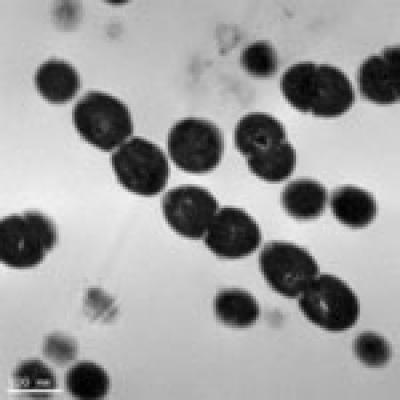Virginia Commonwealth University researchers have decoded the genome of a bacteria normally present in the healthy human mouth that can cause a deadly heart infection if it enters the bloodstream.
The finding enables scientists to better understand the organism, Streptococcus sanguinis, and develop new strategies for treatment and infection prevention. Transmission electron micrograph of S. sanguinis. Credit: Image courtesy of Lauren Turner/VCU.
Transmission electron micrograph of S. sanguinis. Credit: Image courtesy of Lauren Turner/VCU.
S. sanguinis, a type of bacteria that is naturally present in the mouth, is among a variety of microorganisms responsible for the formation of dental plaque. In general, S. sanguinis is harmless. However, if it enters the bloodstream, possibly through a minor cut or wound in the mouth, it can cause bacterial endocarditis, a serious and often lethal infection of the heart.
Individuals with preexisting heart problems are at an increased risk of developing bacterial endocarditis. The infection may result in impaired heart function and complications such as heart attack and stroke. Typically, before dental surgery, such patients are given high dose antibiotics to prevent infection.
Decoding S. sanguinis, a streptococcal bacteria, will provide researchers with unique insight into its complex life cycle, metabolism and its ability to invade the host and cause bacterial endocarditis.
"We can apply this information toward the design of new treatments and preventative strategies to protect against this disease," said lead investigator, Francis Macrina, Ph.D., VCU’s vice president for research. "Analysis of the genome revealed a surprising number of proteins on the S. sanguinis cell surface that may be new targets for drugs or vaccines. We are already at work pursuing some of these leads."
Although it is not directly associated with tooth decay or gum disease, S. sanguinis is a prominent member of dental plaque. "Genomic studies of this organism will also help us better understand the formation of dental plaque and the initiation of oral diseases," added Macrina.
The team reported that the genome of the gram-positive bacterium is a circular DNA molecule consisting of approximately 2.4 million base pairs. They analyzed the S. sanguinis genome and found that it was larger than other streptococci that have been sequenced. Some of this extra DNA was apparently adopted from another bacterium and encodes genes that may give S. sanguinis the ability to survive better in the face of good oral hygiene. If so, this could explain the recent emergence of S. sanguinis as an important pathogen.
"The sequence of the S. sanguinis genome gives us a comprehensive view of the biological potential of this important pathogen," said Gregory A. Buck, Ph.D., director of the Center for the Study of Biological Complexity at VCU, who directed the sequencing and analysis. "This data opens a window into the inner workings of this bacterium. We now may be able to determine how and why these organisms cause disease."
The findings were reported in the April 2007 issue of the Journal of Bacteriology, which is published by the American Society of Microbiology.
Macrina and Buck collaborated with other VCU researchers from the Philips Institute of Oral and Craniofacial Molecular Biology, the Center for the Study of Biological Complexity, the Department of Microbiology and Immunology and the Department of Biochemistry and Molecular Biophysics. Joao M. Alves and Ping Xu, Ph.D., share the honor of first authorship on this manuscript. Other researchers included Todd Kitten, Ph.D., Zhenming Chen, Ph.D., Luiz S. Ozki, Ph.D., Patricio Manque, Ph.D., Myrna G. Serrano, Ph.D., Arunsri Brown, Ph.D., Xiuchun Ge, Ph.D., Daniela Puiu Ph.D., Stephanie Hendricks, Ph.D., Yingping Wang, Ph.D., Michael D. Chaplin, Ph.D., Doruk Akan, Ph.D., Sehmi Paik, Ph.D., and Darrell L. Peterson, Ph.D.